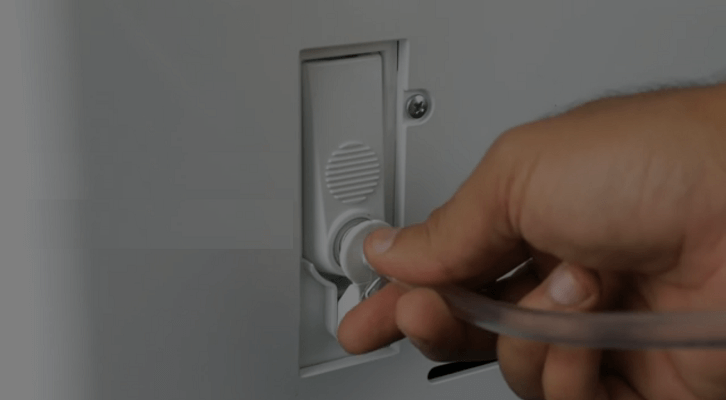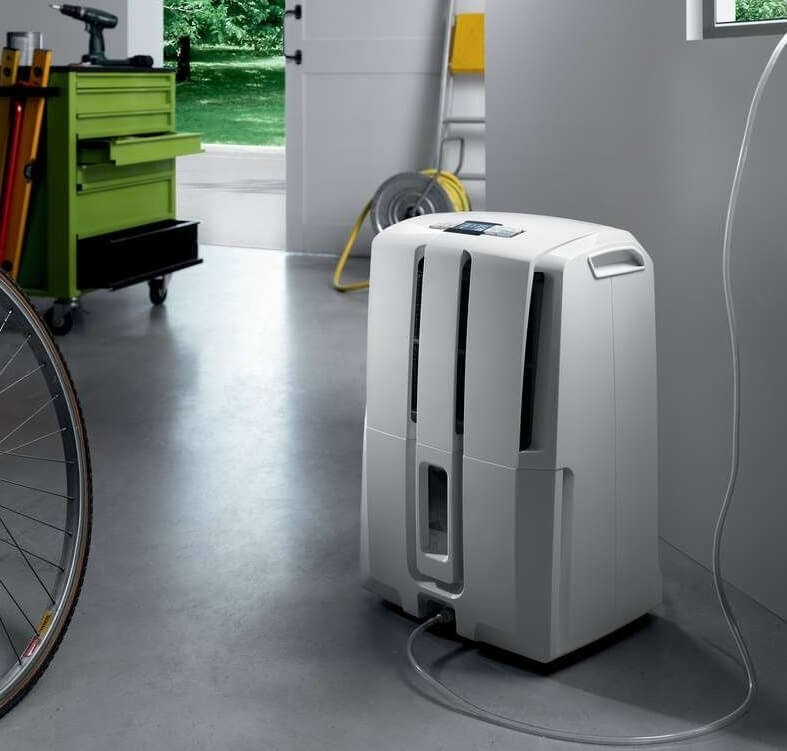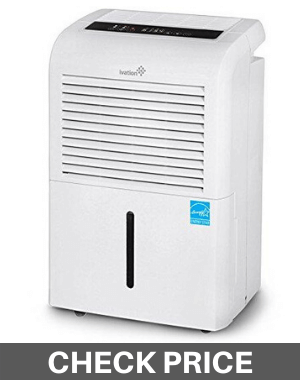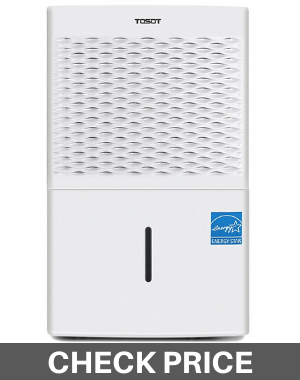All dehumidifiers have to be regularly drained to keep them working optimally. With a dehumidifier that has a pump, you can pump water upward into a sink or out of the basement window. This gives a user versatility and is also favorable to use for most people who cannot move around freely. We’ve put together a list of the best dehumidifiers with a pump as well as some useful buying advice. No matter what your budget is, or the size of your room, you will find something for you below. Enjoy.
Best Dehumidifier With Pump
1. Ivation 4 W/Pump
Type: Refrigerant
Capacity: 70 Pints
Pump Water Height: 16.4 ft.
Pros: Works well to lower the humidity, low fan setting is pretty quiet, easy setup, easy to clean air filter, Clear controls and indicators
Cons: it does get a little noisy, can raise the temperature
The Ivation model IVADH70PWP2 4,500 Sq Ft W/Pump is one the best dehumidifier in the market that comes with a pump function. The dehumidifier is a solid unit and has an overall compact design. The Ivation 4 is easy to set up and the controls are on the top control panel. Everything you need to control the dehumidifier from the ON/OFF, fan speed, timer, and other features can be accessed from the top panel.
The model takes in moist air from the front side with a top vent that dissipates dry air. The front intake has a washable air filter. The filter, though not effective like the ones of an air purifier, does collect dust and other small particles in the air. Proper maintenance of the filter by washing it when dirt builds up is advised to keep the unit functioning properly.
The Ivation 4 W/Pump works great to move the humidity numbers. Within hours of operation, you can feel the difference. It runs a bit noisily and will give out a decent amount of heat when it starts running. However, after a while when it reaches the set humidity level, you can feel space is not warmer than normal.
At the bottom of the unit, there is a 70-pint drain reservoir to collect condensate. In a high humidity area where you are required to empty the reservoir regularly, the continuous drainage outlet or the drainage pump outlet at the back of the unit offer good alternatives. The pump function is easy to set up and automatically works when the hose supplied is connected. The pump bypasses the reservoir which helps in avoiding bacteria and mold build-up in the water tank reservoir. According to Ivation, the pump works up to a height of 16.4 ft. The height we tested was 5ft through the basement window and it worked well.
Best For Crawl Spaces and Basements
2. AlorAir Sentinel HDi90 –
Type: Refrigerant
Capacity: 90 Pint
Pump Water Height: 14.7 ft.
Pros: Well built, simple to set up and operate, comes with remote control function
Cons: Remote control kit needs to purchased separately
The AlorAir Sentinel HDi90 is not your usual dehumidifier. This is a dehumidifier specifically designed for crawl spaces and basements that experience high humidity, especially during rainy seasons. It is a heavy unit, but handles on top should help two people carry it. It looks and feels very solid, plus it has an attractive design.
The AlorAir Sentinel HDi90 features all the controls on the front. The control panel is very simple but features all the primary buttons you require to get the dehumidifier working. The unit also has remote monitoring capability, but you will have to purchase the remote kit separately. The intake is also on the front of the unit and has a mesh filter installed. The Sentinel HDi90 does not come with the G3 filter that is specifically made for this unit so you will need to order one if you buy this dehumidifier.
Once set up and working correctly, the Sentinel HDi90 lowers the humidity down in no time. It moves a lot of air, which helps in reducing the humidity levels faster. The dehumidifier can run continuously by setting the humidity below 36%. For a dehumidifier this size, it is also relatively quiet when running.
AlorAir Sentinel HDi90 offers two ways to drain water from the reservoir. Pressing the drain pump button will remove water from the unit. This is a great option if you do not want the unit to continuously work. when the water level is high, the pump will stop until the water is drained or the pump is plugged. To use the pump, you simply need to insert the 16ft hose provided to drain hose on the front part of the unit and turn it on. The pump can pump to a height of slightly over 14 ft.
Best of the Rest
3. TOSOT Dehumidifier with Internal Pump
Type: Refrigerant
Capacity: 45 Pints
Pump Water Height: 15 ft.
Pros: Quiet working operation, works well, pump feature works well, easy to use settings
Cons: The build quality is not great, instructions provided could be made better
If you are looking for a cheap dehumidifier with a pump, the TOSOT GDN45BA-A3EBA2B model is the budget option we have on this list. The dehumidifier is well made with mostly cheap plastic but it should last longer if properly taken care of. Apart from the build, the design of the TOSOT is compact, and the dehumidifier looks great.
The TOSOT dehumidifier is easy to set up and get running out of the box. The biggest surprise is how quiet the dehumidifier operates. All the buttons, controls, and display feature at the top of the dehumidifier. The air exhaust also features on the top while the air intake vents are on the front. The dehumidifier also comes with a washable air filter that protects the dehumidifier but also helps purify the air. The air filter is to be changed after 250 hours, and a light indicator will illuminate to alert you.
As a dehumidifier, the TOSOT performs flawlessly to maintain the humidity, but it’s nothing spectacular. Once the bucket if full, the dehumidifier shuts down. The bucket is easy to remove, but seems very flimsy and should be handled with the care of according to the instructions provided. The dehumidifier also includes a gravity drain nozzle on the left side of the unit. The dehumidifier does not include the gravity drain hose but it should work with a 3/4″ hose if you have it.
The pump feature of the dehumidifier is can be used once the bucket reaches like 80% capacity. A drainage hose that is supplied by TOSOT should be used or water will leak out. Most user reviews complain about removing the push/pull fitting. To insert the drainage hose, simply push the grey collar and pull out the green drain plug. The Hose included is generously long and the dehumidifier pumps condensate higher from the basement floor. However, one this we observed is that the pump did not empty the reservoir completely, which could lead to mildew and mold growth in the tank if not properly maintained.
4. Frigidaire 70-Pint Dehumidifier with Built-in Pump
Type: Refrigerant
Capacity: 70 Pint
Pump Water Height: 16.4 ft.
Pros: Remembers settings after a power outage, relatively quiet compared to other dehumidifiers, powerful fan, easy setup, nice looking design
Cons: hard-to-follow instructions
The AlorAir Sentinel HDi90 dehumidifier that features in this list is a good option for your crawlspace or basement. However, if you are not looking to spend a fortune on a dehumidifier, this Frigidaire model is a good powerful alternative you can check out. It can also cover a large area, and most importantly comes with a pump. Let’s get into the details below.
First, the dehumidifier seems well built, and we have no complaints about the build quality. The air intake vents are on the back of the unit, which limits its placement. For someone who prefers a minimalistic design, then this should not be negative. The dehumidifier has a removable air filter that can also be washed. The controls panel is on the top and the exhaust vent features on one side. It is easy to set up and can be easily moved around.
The performance of the Frigidaire FFAP7033T1 is good, and the dehumidifier does reduce the humidity levels. Different fan speeds give the unit more functionality, and you can change the speed from high, medium, and low. In our test, the auto on/off feature was the best to have and leave the unit working. What we also loved about this dehumidifier was when there is a power outage, it will automatically restart from the previous settings.
Once the bucket is full, the dehumidifier indicator will illuminate. There are three ways you can remove collected water. First, you can remove the bucket, which is a very easy process. Second, you can use a garden hose to continuously drain to a water container. Third, you can use the hose supplied to pump the water through the basement window, floor drain, or a water container. The maximum height we could pump with the pump is roughly about 4-meters.
The pumping mechanism of the Frigidaire FFAP7033T1 is good. However, one challenge we’ve identified after combing through several user reviews was how difficult it is to remove the plug from the pump socket. The dehumidifier uses a simple push/pull connection which can be challenging to use and set up. However, you just need to push the grey collar and pull the green plug.
Dehumidifier with Pump Buying Guide
How Dehumidifiers Work
A dehumidifier works by reducing and regulating the humidity of a room by removing moisture from the air. A dehumidifier is like a vacuum cleaner that sucks air, removes moisture, and blows it out into the room again. There are two ways or rather two main types of dehumidifiers available. The most popular are refrigerant dehumidifiers and there are also absorption/desiccant dehumidifiers.
Absorption or desiccant dehumidifiers work by using a water-absorbing material. First, moist air is drawn in and passed through a moisture absorbing material, which absorbs moisture and blows out dry air. The desiccant material is also simultaneously heated to release moisture. When heated, warm and wet air generated is exhausted outside the home or office.
Though they are not popular and effective like a refrigerant dehumidifier, desiccant dehumidifiers can be the best option in some situations. They are generally smaller and so they can be good for smaller spaces like bathrooms, closets, or other storage areas. They are also quieter compared to refrigerant dehumidifiers. If you also need a dehumidifier that works at a greater range of temperatures, a desiccant dehumidifier is your pick. At lower temperatures, when refrigerant dehumidifiers are less effective, desiccant dehumidifiers are more efficient.
Refrigerant or Compressor dehumidifiers work by utilizing a very simple process. Have you’ve ever noticed how moisture forms on a windowpane in the morning? that’s condensation, and that’s how a refrigerant dehumidifier works. First, warm moist air is drawn into a dehumidifier by a fan. The air passes through the coils of the dehumidifier can come out dry. Much like how moisture condenses on a windowpane, the coils of a dehumidifier are colder than the air drain in. As air passes through the coils, it cools down and loses the ability to hold the water molecules. The water condenses on the coils and drips into a drip pan or removable bucket for easy disposal. Other dehumidifiers such as the one that features in this list will come equipped with a built-in pump that allows continuous drainage.
Read our in-depth article on how dehumidifiers work.
Dehumidification Performance
Dehumidification performance refers to the capacity of dehumidification of a particular dehumidifier. In this article, dehumidification performance is denoted by the term capacity. The capacity refers to how much moisture content a dehumidifier can remove from the air in a day. Most of the dehumidifiers in this list have a 70-pint capacity.

A 70-pint capacity means the dehumidifier can remove 70 pints or roughly 33 liters of water in a day at standard room conditions (65 degrees F, 60% humidity). The capacity should not be confused with the pint storage which refers to the size of the condensate reservoir bucket. You may have a 70-pint dehumidifier, but the maximum the dehumidifier’s condensate bucket can hold is only 20 pint. This means you will have to manually drain the dehumidifier or use other draining methods like continuous gravity drain or pumping available in some dehumidifiers.
Dehumidifier Room Placement
Portable dehumidifier units offer more flexibility in terms of their placement around a home. So, where do you need to place your dehumidifier for maximum performance?
First, ensure you place the dehumidifier away from any obstacles that will block airflow. Dehumidifiers work by drawing in the air using fans to remove moisture. An obstacle blocking the intake point will lead to reduced performance. Also, check the manufacturer’s instructions and pay careful consideration to the design of the dehumidifier. For example, a dehumidifier with a front air intake and a top-mounted discharge can be placed near a wall without affecting its performance.

High humidity areas such as bathrooms, basements, and crawl spaces are also some ideal locations you can place your dehumidifier for best results. When working dehumidifiers will be noisy and some will also release heat. be sure to factor in what impact these will have on your environment. For example, a loud dehumidifier will be better off in the kitchen than in your bedroom especially at night. Read our in-depth article on dehumidifier placement.
Advantages of Dehumidifiers with a Pump
Most consumer-grade dehumidifiers have a tank that needs to be periodically dumped out or they will stop functioning altogether. Some dehumidifiers will offer a drain hose that can be used to drain the tank. However, these rely on gravity and will not work if they are not elevated. A dehumidifier that comes with a pumping mechanism avoids all these problems.

The main benefit of a dehumidifier with a pump is that it can be set to automatically drain water out by pumping. This offers convenience that you can leave the dehumidifier working without worrying about its operation. In harder to reach places, a dehumidifier with a pump makes it easy to drain water out instead of manually reaching down there every time you need to dispose of the collected water. In a basement area, most dehumidifiers with a pump offer a pumping height of 13-16 ft., which can be directed to drain the water out through the window. Read about this in the following section.
Read our post on how to drain a dehumidifier to the outside.
Drain Height Explained
The drain height of a dehumidifier in this article refers to how high a dehumidifier can pump condensate. Before purchasing a dehumidifier, if you are planning to use the pumping feature, you should be aware of a dehumidifier’s drain height. In this article we have outlined every dehumidifier pumping height so can choose one that fits your specification.
If you are draining condensate into a sink or a floor drain to a sump pump, the pumping height does not have to be big. however, draining condensate up through a window will require a powerful dehumidifier to push the water. Be sure to check the height for the dehumidifier to work correctly. If the height exceeds the recommended pumping height, you risk destroying the dehumidifier or water leaking.
Condensate Pumps Explained
A condensate pump is a type of pump that is used to pump water produced (condensate) by home heating, cooling, refrigeration, steam systems, condensing boiler furnace, and in this case dehumidifiers. If you currently own a dehumidifier that can utilize gravitational force to drain water out, then a condensate pump is an option you could consider instead of investing in a dehumidifier with a pump. When choosing a condensate pump, first determine the lift requirement of the pump. Figure out where the unit will be mounted and where it will discharge the condensate. Select a pump that can be able to effectively pump water based on the height you need.





